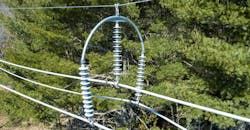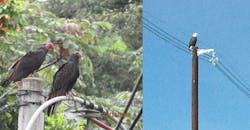Introduction
The construction of power lines (distribution as well as transmission) in environmentally sensitive areas has always been a challenge. Special considerations need to be given to the protection of wildlife, as well as the minimization of tree and foliage removal. The environmental objectives then are to cut less trees and protect more animals. The design of aerial covered conductor, by providing an outer covering which limits the contact current to a small fraction of a milliamp, can be utilized to not only avoid outages caused by animals (birds, squirrels, snakes, and other tree dwelling creatures), but protect those animals as well. In addition, the compact and robust nature of covered conductor systems can minimize the need for tree and foliage removal.
Numerous studies have addressed the relationship between animals and powerline reliability rates. One utility noted animals account for around 24% of all distribution outages. This number is on the low side, since a large part of outage reporting is chalked up to “Unknown”, another 12% of outages, which usually can be traced back to trees or animals. So, there are significant opportunities to improve reliability and take care of the flora and fauna.
Various reliability studies show that trees account for about 35% of all distribution voltage outages. The public at large often voices objections to tree removal or trimming, citing aesthetic reasons or a desire to preserve animal habitats. As a result, utilities are routinely forced to leave trees in place, suffering the related outages, costs to repair, as well as revenue loss and related damages from those outages, not to mention negative press coverage. Covered conductor systems offer a mechanism to minimize tree removal or trimming while also reducing tree related outages.
What are Covered Conductor Systems?
Covered conductor systems use standard aluminum (AAC, AAAC, and ACSR) and copper conductors, with a 3-layer covering extruded on top of the bare wire. The coverings include a thin semicon layer (to smooth out electric fields when in contact with a grounded object), an inner layer of low-density polyethylene (which provides a high BIL and is soft to enable stripping for taps, transitions, and line extensions), and an outer layer of high-density polyethylene (providing UV inhibition, track resistance, abrasion resistance, and color). The total thickness of the three layers depends on the voltage class, as the design objective is to limit the available surface current should the phase conductor come into contact with a tree or other grounded object.
There are two configurations for covered conductor systems. Spacer Cable Systems utilize three heavily covered, but non-shielded conductors, supported by a high strength messenger (strength member, system neutral, lightning shield, and mechanical protector against things which may fall on the bundle from above), with the phases connected to the messenger by spacers every thirty feet. Tree Wire systems, on the other hand, look more like bare wire construction. They utilize the same 3-layer covered conductor design, but the phase conductors are usually either ACSR or AAAC (since it is fully self-supported and tensioned). It is strung in an open wire configuration on crossarms with polyethylene insulators.
How Spacer Cable Systems Benefit the Environment
One method to protect trees and foliage is to consider powerline Right-of-Way (ROW) reduction. This can be achieved by using compact, low profile spacer cable systems. Since the phase conductors of a spacer cable system are inches apart, rather than several feet, reducing the width of the powerline bundle can directly translate into an opportunity to consider a reduction in ROW width. This ROW width reduction can be achieved at distribution voltages, with even larger ROW reduction at transmission voltage levels. At medium voltage levels, the ROW reduction might be ten feet or more, but at transmission levels, the ROW width reduction can be very significant, upwards of 18 feet or more. While this width reduction may seem small, for a long line, this can equate to thousands or even tens of thousands of trees. There are two hundred thousand miles of transmission lines in the US, and another 5.5 million miles of distribution lines. Possibilities for improvements are astronomical.
The more trees left undisturbed, the greater the carbon capture of greenhouse gases. Since trees absorb carbon dioxide and produce oxygen, green spaces counteract a significant amount of carbon pollution (fossil fuel burning by cars, power plants, buildings, etc.), slowing the rate of CO₂ entering the environment. Trees also keep the air clean and help avoid health issues for humans living in the vicinity.
Trees also serve as a habitat for birds and other animals. Humans have expanded their habitat into areas that were formerly pristine, with varied wildlife. Now those animals are forced to sacrifice safety by coexisting with energized power lines. The number of bird and animal fatalities annually is disturbing. Records show that millions of birds are killed each year from powerline collisions, and many more from electrocutions. Spacer cable provides a bundle which is visible to birds in flight, so they can alter their trajectory when approaching and avoid a collision. And, in case they get between an energized covered conductor and a ground point, the negligible surface current a bird may encounter is insufficient to cause harm. It is common for birds, including large raptors, to perch on covered conductor lines without issues, as shown in the photos below.
There are cases where a flock of birds sitting on a powerline alight simultaneously and cause a flashover between phases. This is not possible with covered conductor systems, due to the protection afforded by the insulation.
As far as animals touching lines, the surface current for a 15 kV system is on the order of 1/3rd of a milliamp, which is a fraction of the fibrillation threshold for humans, and also for most of the tree dwelling animals encountered. Time and again we gather testimonials from utilities exclaiming pride that spacer cable has saved animals from contact that otherwise would have resulted in fatalities. The photo below shows an area which is teeming with numerous species of monkeys, which travel in and out of spacer cable lines without harm.
Other tree dwelling animals include sloths, anteaters, and scores of other animals. One other danger to animals is downed powerlines which remain energized. Farm animals and pets are killed each year in this scenario. With covered conductor, however, there isn’t enough current to cause injury.
Summary
The benefits of using covered conductor for both distribution and transmission aerial power lines are: improved reliability, vastly reduced tree trimming, improved Power Quality (better voltage regulation and power factor), system hardening (harsh weather resilience as well as wildfire mitigation), ease of multiple circuit construction, and improved economics. Covered Conductor systems also provide utilities with a viable tool to invest in environmental stewardship, protect the trees, provide carbon capture, and make life safe for tree dwelling animals.
Sponsored by:


